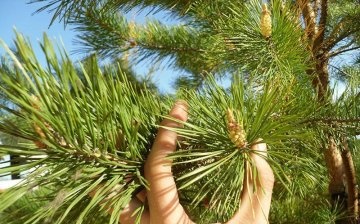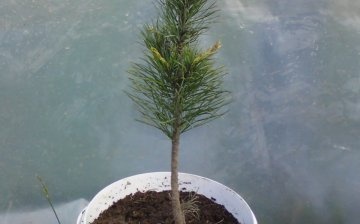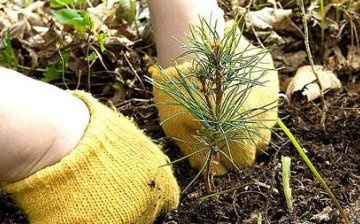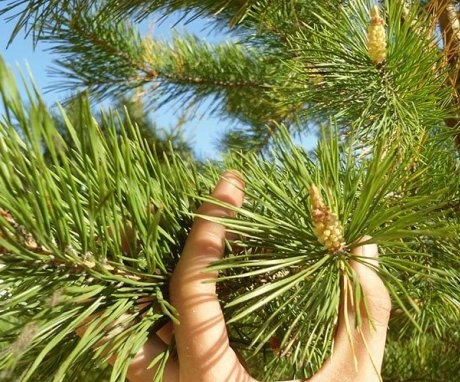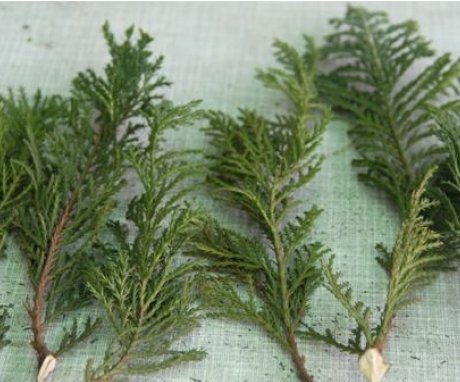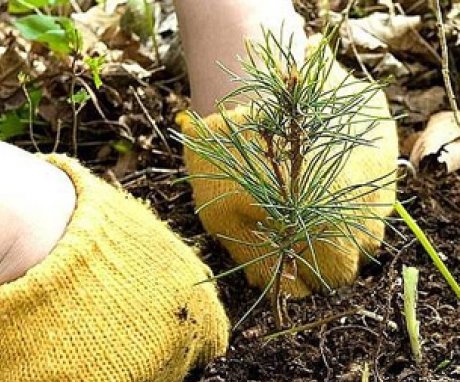How to grow a pine tree from a branch: preparation and rooting
Pine is a rather beautiful and neat tree of the gymnosperm division. It is planted to decorate streets, alleys and courtyards. In addition, the active compounds it produces cleanse the air from harmful microorganisms. Many grow pine seed or planting young pines. Is it possible to grow a beautiful tree from a small twig? Now we will find out about this by considering the technology of growing pine from its small twig.
Content:
- Selects a branch of pine to grow
- Preparation before landing
- Getting rooted pine twigs
- Planting in open ground
Selects a branch of pine to grow
As strange as it sounds, many representatives of conifers can be propagated using a branch or a small stalk... This method is quite painstaking and requires a lot of patience, but if you are a plant lover, this is nothing for you. Consider the process breeding and cultivation conifers, for example, Scots pine, since it is a fairly common representative of gymnosperms.
Growing secrets:
- The first thing we need is to decide on the type pine treeswhich we are going to grow from the branch. In the conditions of the middle zone of our country, Scots pine mainly grows, then we will try to grow it.
- First you need to find a growing pine tree and take this year's twig from it. Its stem can be lignified or semi-lignified, either way it will do.
- Gently cuts off a small twig, and we carry it home. Since the Scots pine is a rather unpretentious plant in growth, it should not be very difficult to root the resulting branches.
- Among other representatives of conifers, the process of rooting a pine branch takes much less time compared to such a plant as yew or juniper... This circumstance is quite pleasant for those who want to get roots on a pine branch in a short period of time.
- The most favorable time for cutting pine branches for planting is from June to July. During this period, the twigs have already formed and many of them, thanks to the still released hormones, are in the phase of active growth. In addition, there is a sunny summer ahead with a long daylight hours during which the pine twigs must take root.
- If the branches are cut at a later period, then autumn and winter with short daylight hours are ahead.
Rooting of pine branches during this period will be much slower, since the intensity of photosynthesis will be reduced due to the short day. In such cases, to speed up the process, it will be necessary to create artificial lighting that can positively affect the formation of roots in a young pine twig.
The younger the branch cut for rooting, the faster the first roots will appear on it.
Therefore, it is better to choose semi-lignified or completely green pine twigs. This method of reproduction of gymnosperms is considered asexual, and the resulting plant will be identical to the mother.As a result of such reproduction, new gene variations are not obtained, and the genetic material of the cut pine branch remains unchanged.
Preparation before landing
In order to get a new Scotch pine plant from a simple twig, you do not need to involve complex equipment and sophisticated technologies. This process is within the power of everyone and can be carried out in simple at home.
The main inventory for these procedures will be a pruner, preferably well sharpened, and a container for planting small branches.
A sharp pruner will help you to quickly cut the selected branch without staining you with the escaping resin. Scotch pine, like many representatives of gymnosperms, is filled inside not with sap, but with resin, which is quickly released when the integrity of its branches is violated. The resin is rather sticky, gives off a pleasant aroma and is not easily washed from hands and clothes. Therefore, it is worth cutting off the branch as soon as possible and moving away from the tree.
Preparation tips:
- In the role of capacity under landing an ordinary small frame made of wood... A small amount of compost is placed in this frame. The speed will also depend on the composition of the compost. rooting pine twigs. The more fertile it is, the faster the process of root formation will begin.
- In fertile compost, young roots will be able to gain strength and gain a foothold faster. The best option for compost in this case may be a mixture consisting of coarse river sand and peat, uniform in consistency. Prepare such a mixture by mixing these components in a one-to-one ratio.
- In order to prevent diseases rooted pine twigs, a little half-rotted pine bark is often added to the prepared compost. If you do not have it at hand, you can use coarse peat as its substitute.
- In addition, these components will perform the function of good drainage for growing branches. Sometimes a small amount of perlite is added to the compost, which helps to improve the aeration of the resulting mixture.
- Access of oxygen to the roots of a pine branch is also very necessary and important, and it can be achieved using the above action. It is advisable to moisten it before planting the branches in the resulting compost. It will also help the twigs take root and gain strength faster.
- Good watering can be done simultaneously with the disinfection of the mixture. As you know, peat contains a large number of microorganisms and many of them can negatively affect the growth and development of a young pine branch. In this case, a young twig can get sick and even die. To prevent this from happening, the resulting mixture should be disinfected with a weak solution of potassium permanganate or, as the people call it, potassium permanganate.
The process of preparing such a solution is very simple: a few crystals of potassium permanganate (usually at the tip of a knife) are added to a small amount of boiled water at room temperature to form a slightly pink solution. They then need to shed the soil before planting pine branches in it. Crystals of potassium permanganate have a detrimental effect on most pathogenic microorganisms found in peat.
Getting rooted pine twigs
By choosing the one you like wood Scots pine, with the help of a sharp pruner (in the absence of it, a sharp knife will also do), cut a branch of a small length. Then you need to remove the existing branches to its bottom in order to free this zone in order to get roots on it. The size of the cut branch should not exceed ten centimeters. This is the most optimal length for this case. You can use smaller pine branches, they are also capable of rooting.If there are other extraneous branches on the selected branch, they should also be removed.
To get roots on a branch, you need a stimulant substance for root formation. It can be a common growth agent or a root stimulant.
You can buy such a substance in specialized flower shops. It releases as a liquid or solution. Please read the description before purchasing drug and the category of plants that it works well for.
Then the cut twig must be dipped into the prepared root former solution. Prepare the solution according to the existing drug instructions. The concentration of the root stimulator solution is directly proportional to the degree of lignification of the pine branch you have chosen. The stronger the lignification of its lower part, the more concentrated the prepared solution should be. If you decide to root a pine twig in the summer, then you may not need a root stimulant.
Planting a pine twig:
- They should be planted in a prepared frame with a special compost, which was mentioned earlier. If you do not have such a frame, then you can plant these branches in a regular greenhouse. Both the frame and the greenhouse should be covered with foil.
- When planting, it is not advisable to stick the twigs into the soil, this can negatively say on future root formation. It is best to make a small hole in the compost with a hard object and place a pine branch in it. After that, the soil around the branch should be gently pressed and compacted.
- For prevention development of various diseases on the surface of pine branches, it is recommended to spray with a special fungicide solution. After that, the planted pine branches are covered to speed up the root formation process.
- It is best for sprouting twigs to create partial shade conditions by covering them from direct exposure to harmful sunlight. A frame with twigs can be placed in partial shade conditions.
- When rooting pine branches in winter, it is advisable to warm up the frame with the planted branches. This will help speed up the root-forming process. It is important to ensure that the pine branches receive a sufficient amount of moisture, otherwise they will not only be unable to form new roots, but also perish themselves.
- Moderate watering should be done as needed. If there is more moisture than necessary, the plants may die from waterlogging and decay.
- After a while, you should start to open the greenhouse or frame to ventilate the pine branches. Access to fresh air and sunlight has a positive effect on plant root growth.
Planting in open ground
If you were engaged in cutting branches pine trees for rooting in early summer, then by August they should have formed roots. It is by their presence that they judge the need to plant pine nets in open ground.
The stronger and stronger the root system of pine branches, the more chances for their early fixation in the soil and active growth.
In the case of getting rooted branches, and you can check this by carefully excavating the top layer of soil around them, you can start planting. It is advisable to plant rooted pine twigs in a semi-shady area when there is no bright sun outside.
After this, the plant follows well to water and look after... Subject to all standards of care, after several years a beautiful pine tree will grow in this place. In this way, you can grow a beautiful pine tree from its small twig with diligence and care.
More information can be found in the video.




